Choose your iMac model
If you're not sure which iMac you have, you can identify your iMac and select it from the list below.
27-inch
- iMac (Retina 5K, 27-inch, 2020)
- iMac (Retina 5K, 27-inch, 2019)
- iMac (Retina 5K, 27-inch, 2017)
- iMac (Retina 5K, 27-inch, Late 2015)
- iMac (Retina 5K, 27-inch, Mid 2015)
- iMac (Retina 5K, 27-inch, Late 2014)
- iMac (27-inch, Late 2013)
- iMac (27-inch, Late 2012)
- iMac (27-inch, Mid 2011)
- iMac (27-inch, Mid 2010)
- iMac (27-inch, Late 2009)
24-inch
- iMac (24-inch, 2023)1
- iMac (24-inch, M1, 2021)1
- iMac (24-inch, Early 2009)
- iMac (24-inch, Early 2008)
- iMac (24-inch, Mid 2007)
21.5-inch
- iMac (Retina 4K, 21.5-inch, 2019)3
- iMac (Retina 4K, 21.5-inch, 2017)3
- iMac (21.5-inch, 2017)3
- iMac (Retina 4K, 21.5-inch, Late 2015)2
- iMac (21.5-inch, Late 2015)2
- iMac (21.5 inch, Mid 2014)3
- iMac (21.5-inch, Late 2013)3
- iMac (21.5-inch, Late 2012)3
- iMac (21.5-inch, Mid 2011)
- iMac (21.5-inch, Mid 2010)
- iMac (21.5-inch, Late 2009)
20-inch
- iMac (20-inch, Early 2009)
- iMac (20-inch, Early 2008)
- iMac (20-inch, Mid 2007)
- iMac (20-inch, Late 2006)
- iMac (20-inch, Early 2006)
17-inch
- iMac (17-inch, Late 2006 CD)
- iMac (17-inch, Late 2006)
- iMac (17-inch, Mid 2006)
- iMac (17-inch, Early 2006)

iMac (Retina 5K, 27-inch, 2020)
Get memory specifications for iMac (Retina 5K, 27-inch, 2020), then find out how to install memory in this model.
Memory specifications
This iMac model features Synchronous Dynamic Random-Access Memory (SDRAM) slots on the rear of the computer near the vents with these memory specifications:
| Number of memory slots | 4 |
| Base memory | 8 GB (2 x 4 GB DIMMs) |
| Maximum memory | 128 GB (4 x 32 GB DIMMs) |
For optimal memory performance, DIMMs should have the same capacity and speed, and be from the same vendor. Use small outline dual inline memory modules (SO-DIMM) that meet all of these criteria:
- PC4-21333
- Unbuffered
- Non-parity
- 260-pin
- 2666 MHz DDR4 SDRAM
If you have mixed capacity DIMMs, see the install memory section for installation recommendations.
iMac (Retina 5K, 27-inch, 2019)
Get memory specifications for iMac (Retina 5K, 27-inch, 2019), then find out how to install memory in this model.
Memory specifications
This iMac model features Synchronous Dynamic Random-Access Memory (SDRAM) slots on the rear of the computer near the vents with these memory specifications:
| Number of memory slots | 4 |
| Base memory | 8 GB (2 x 4 GB DIMMs) |
| Maximum memory | 64 GB (4 x 16 GB DIMMs) |
Use small outline dual inline memory modules (SO-DIMM) that meet all of these criteria:
- PC4-21333
- Unbuffered
- Non-parity
- 260-pin
- 2666 MHz DDR4 SDRAM
iMac (Retina 5K, 27-inch, 2017)
Get memory specifications for iMac (Retina 5K, 27-inch, 2017), then find out how to install memory in this model.
Memory specifications
This iMac model features Synchronous Dynamic Random-Access Memory (SDRAM) slots on the rear of the computer near the vents with these memory specifications:
| Number of memory slots | 4 |
| Base memory | 8 GB (2 x 4 GB DIMMs) |
| Maximum memory | 64 GB (4 x 16 GB DIMMs) |
Use small outline dual inline memory modules (SO-DIMM) that meet all of these criteria:
- PC4-2400 (19200)
- Unbuffered
- Non-parity
- 260-pin
- 2400 MHz DDR4 SDRAM
iMac (Retina 5K, 27-inch, Late 2015)
Get memory specifications for iMac (Retina 5K, 27-inch, Late 2015), then find out how to install memory in this model.
Memory specifications
This iMac model features Synchronous Dynamic Random-Access Memory (SDRAM) slots on the rear of the computer near the vents with these memory specifications:
| Number of memory slots | 4 |
| Base memory | 8 GB |
| Maximum memory | 32 GB |
Use small outline dual inline memory modules (SO-DIMM) that meet all of these criteria:
- PC3-14900
- Unbuffered
- Non-parity
- 204-pin
- 1867 MHz DDR3 SDRAM
For these 27-inch models
Get memory specifications for the following iMac models, then find out how to install memory in them:
- iMac (Retina 5K, 27-inch, Mid 2015)
- iMac (Retina 5K, 27-inch, Late 2014)
- iMac (27-inch, Late 2013)
- iMac (27-inch, Late 2012)
Memory specifications
These iMac models feature Synchronous Dynamic Random-Access Memory (SDRAM) slots on the rear of the computer near the vents with these memory specifications:
| Number of memory slots | 4 |
| Base memory | 8 GB |
| Maximum memory | 32 GB |
Use small outline dual inline memory modules (SO-DIMM) that meet all of these criteria:
- PC3-12800
- Unbuffered
- Non-parity
- 204-pin
- 1600 MHz DDR3 SDRAM
Installing memory
The internal components of your iMac can get warm. If you've been using your iMac, wait 10 minutes after shutting it down to allow the internal components to cool.
After you've shut down your iMac and given it some time to cool down, follow these steps:
- Disconnect the power cable and all other cables from your computer.
- Place a soft, clean towel or cloth on a desk or other flat surface to prevent the display from getting scratched.
- Hold the sides of the computer and slowly place the computer face down on the towel or cloth.
- Open the memory compartment door by pressing the small grey button that's located just above the AC power port:
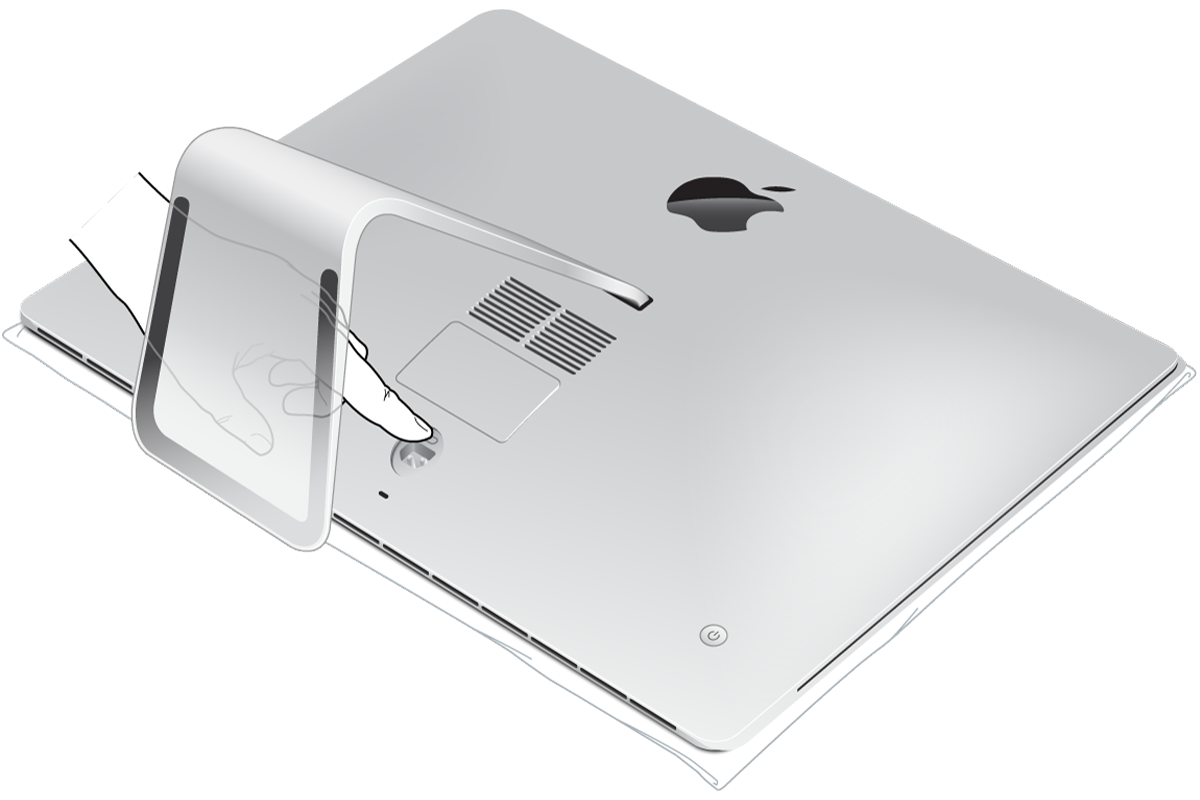
- The memory compartment door will open as the button is pushed in. Remove the compartment door and set it aside:
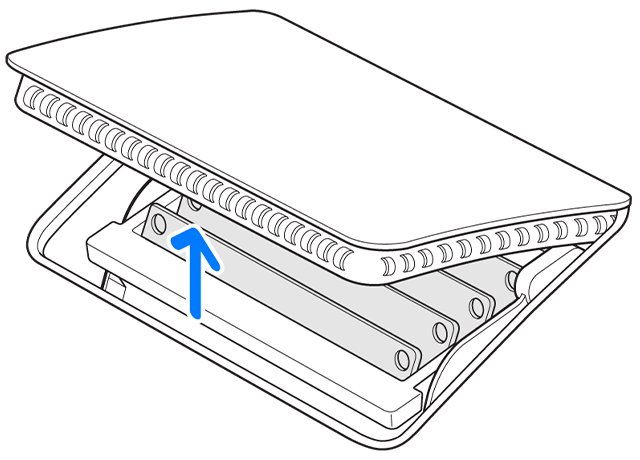
- A diagram on the underside of the compartment door shows the memory cage levers and the orientation of the DIMM. Locate the two levers on the right- and left-hand sides of the memory cage. Push the two levers outwards to release the memory cage:
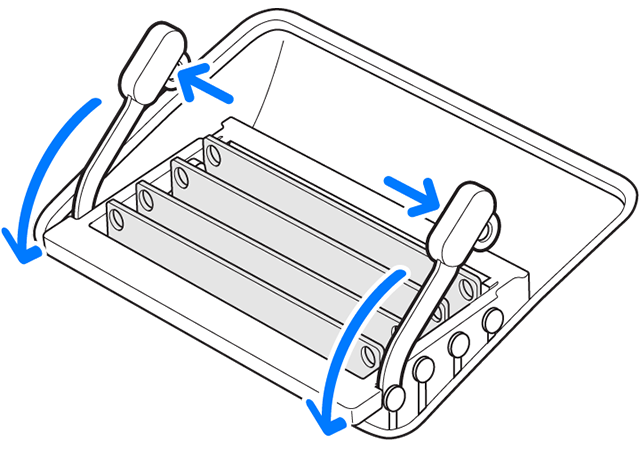
- After the memory cage has been released, pull the memory cage levers towards you, allowing access to each DIMM slot.
- Remove a DIMM by pulling the module straight up and out. Note the location of the notch on the bottom of the DIMM. When reinstalling DIMMs, the notch must be orientated correctly or the DIMM won't be inserted fully:
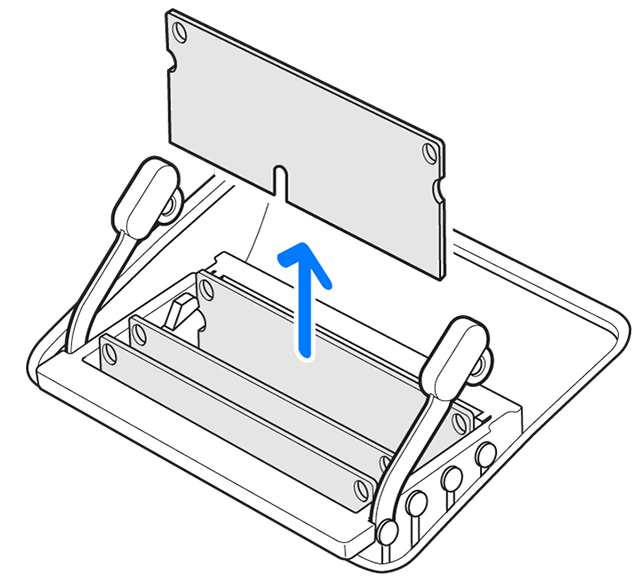
- Replace or install a DIMM by setting it down into the slot and pressing firmly until you feel the DIMM click into the slot. When you insert a DIMM, make sure you align the notch on the DIMM with the DIMM slot. Find your model below for specific installation instructions and notch locations:
- iMac (Retina 5K, 27-inch, 2020) DIMMs have a notch on the bottom, slightly to the left of centre. If your DIMMs are mixed in capacity, minimise the capacity difference between Channel A (slots 1 and 2) and Channel B (slots 3 and 4) when possible.
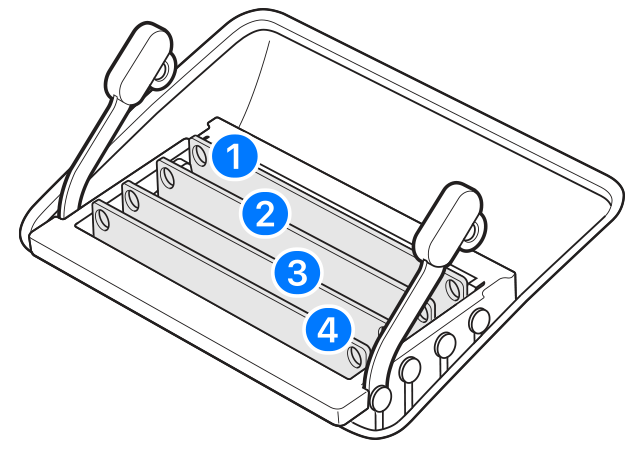
- iMac (Retina 5K, 27-inch, 2019) DIMMs have a notch on the bottom, slightly to the left of centre:
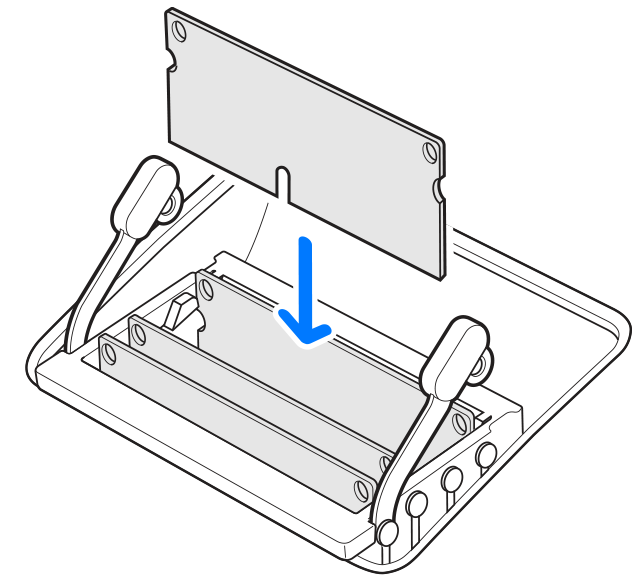
- iMac (27-inch, Late 2012) and iMac (Retina 5K, 27-inch, 2017) DIMMs have a notch on the bottom left:
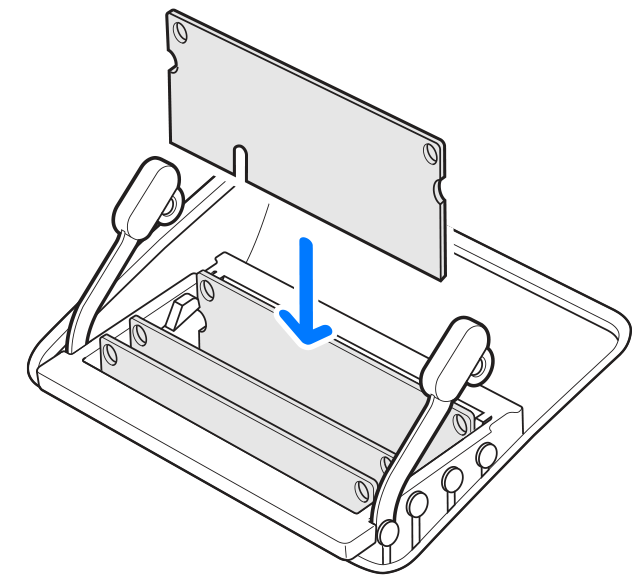
- iMac (27-inch, Late 2013) and iMac (Retina 5K, 27-inch, Late 2014, Mid 2015 and Late 2015) DIMMs have a notch on the bottom right:
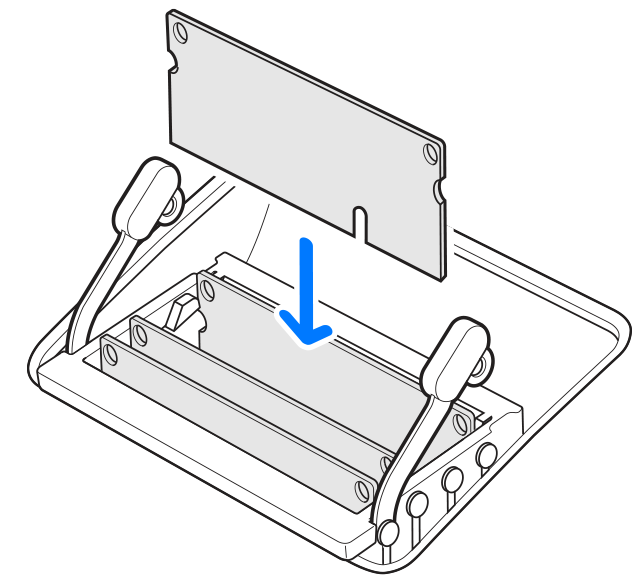
- iMac (Retina 5K, 27-inch, 2020) DIMMs have a notch on the bottom, slightly to the left of centre. If your DIMMs are mixed in capacity, minimise the capacity difference between Channel A (slots 1 and 2) and Channel B (slots 3 and 4) when possible.
- After you've installed all of your DIMMs, push both memory cage levers back into the housing until they lock into place:
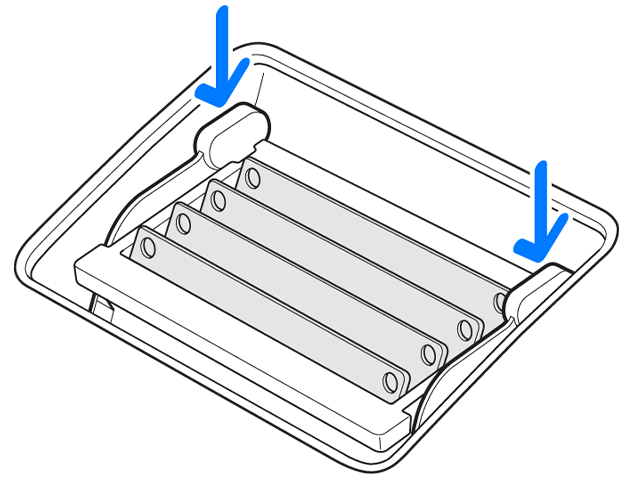
- Replace the memory compartment door. You don't need to press the compartment door release button when replacing the compartment door.
- Place the computer in its upright position. Reconnect the power cable and all other cables to the computer, then start up the computer.
Your iMac will perform a memory initialisation procedure when you first turn it on after upgrading memory or rearranging DIMMs. This process can take 30 seconds or more, and the display of your iMac will remain dark until it's finished. Make sure you allow the memory initialisation process to be completed.

For these 27-inch and 21.5-inch models
Get memory specifications for the following iMac models, then find out how to install memory in them:
- iMac (27-inch, Mid 2011)
- iMac (21.5-inch, Mid 2011)
- iMac (27-inch, Mid 2010)
- iMac (21.5-inch, Mid 2010)
- iMac (27-inch, Late 2009)
- iMac (21.5-inch, Late 2009)
Memory specifications
| Number of memory slots | 4 |
| Base memory | 4 GB (but is configured to order) |
| Maximum memory | 16 GB For iMac (Late 2009), you can use 2 GB or 4 GB RAM SO-DIMMs of 1066 MHz DDR3 SDRAM in each slot. For iMac (Mid 2010) and iMac (Mid 2011), use 2 GB or 4 GB RAM SO-DIMMs of 1333 MHz DDR3 SDRAM in each slot. |
Use small outline dual inline memory modules (SO-DIMM) that meet all of these criteria:
| iMac (Mid 2011) | iMac (Mid 2010) | iMac (Late 2009) |
| PC3-10600 | PC3-10600 | PC3-8500 |
| Unbuffered | Unbuffered | Unbuffered |
| Non-parity | Non-parity | Non-parity |
| 204-pin | 204-pin | 204-pin |
| 1333 MHz DDR3 SDRAM | 1333 MHz DDR3 SDRAM | 1066 MHz DDR3 SDRAM |
i5 and i7 Quad Core iMac computers come with both top memory slots populated. These computers will not start up if only a single DIMM is installed in any bottom slot; these computers should operate normally with a single DIMM installed in any top slot.
Core Duo iMac computers should operate normally with a single DIMM installed in any slot, top or bottom. ("Top" and "bottom" slots refer to the orientation of the slots in the pictures below. "Top" refers to the slots closest to the display; "bottom" refers to the slots closest to the stand.)
Installing memory
The internal components of your iMac can get warm. If you've been using your iMac, wait 10 minutes after shutting it down to allow the internal components to cool.
After you've shut down your iMac and given it some time to cool down, follow these steps:
- Disconnect the power cable and all other cables from your computer.
- Place a soft, clean towel or cloth on a desk or other flat surface to prevent the display from getting scratched.
- Hold the sides of the computer and slowly place the computer face down on the towel or cloth.
- Using a Phillips screwdriver, remove the RAM access door in the bottom of your computer:
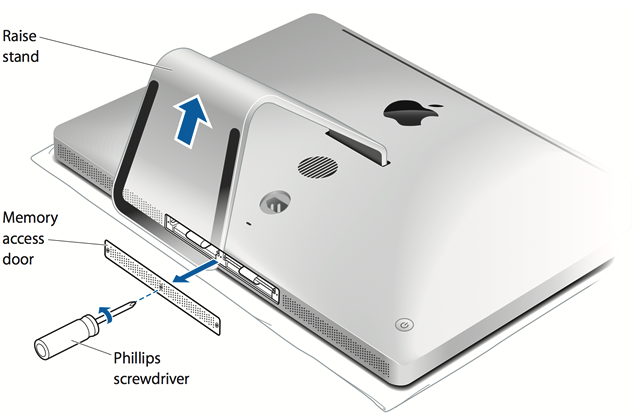
- Remove the access door and set it aside.
- Untuck the tab in the memory compartment. If you're replacing a memory module, gently pull the tab to eject any installed memory module:
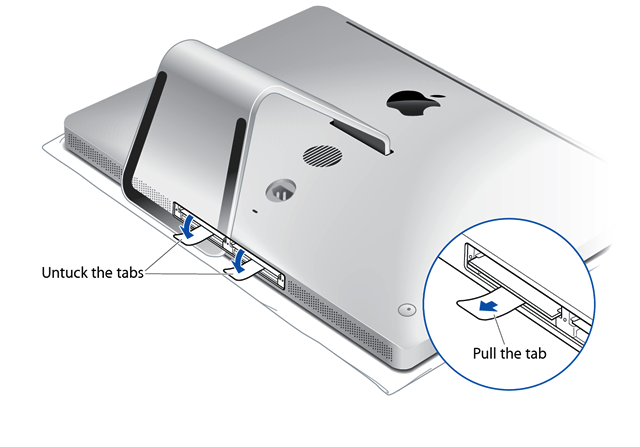
- Insert your new or replacement SO-DIMM into the empty slot, noting the orientation of the keyway of the SO-DIMM as shown below.
- After you've inserted it, press the DIMM up into the slot. There should be a slight click when the memory has been seated correctly:

- Tuck the tabs above the memory DIMMs and reinstall the memory access door:
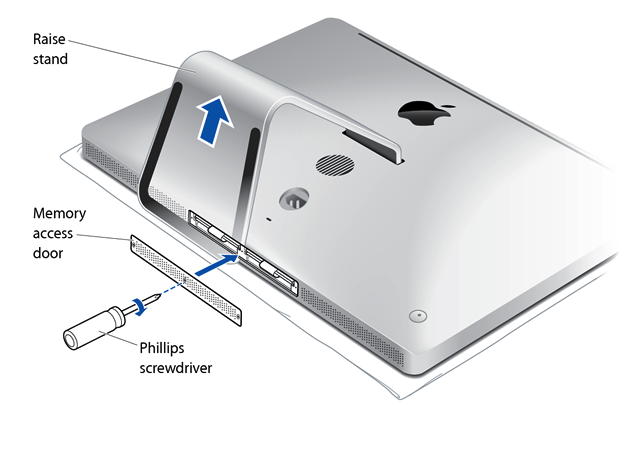
- Place the computer in its upright position. Reconnect the power cable and all other cables to the computer, then start up the computer.

For these 24-inch and 20-inch models
Get memory specifications for the following iMac models, then find out how to install memory in them:
- iMac (24-inch, Early 2009)
- iMac (20-inch, Early 2009)
- iMac (24-inch, Early 2008)
- iMac (20-inch, Early 2008)
- iMac (24-inch, Mid 2007)
- iMac (20-inch, Mid 2007)
Memory specifications
These iMac computers have two side-by-side Synchronous Dynamic Random-Access Memory (SDRAM) slots in the bottom of the computer.
The maximum amount of random-access memory (RAM) you can install in each computer is:
| Computer | Memory Type | Maximum Memory |
| iMac (Mid 2007) | DDR2 | 4 GB (2 x 2 GB) |
| iMac (Early 2008) | DDR2 | 4 GB (2 x 2 GB) |
| iMac (Early 2009) | DDR3 | 8 GB (2 x 4 GB) |
You can use a 1 GB or 2 GB RAM module in each slot for iMac (Mid 2007) and iMac (Early 2008). Use 1 GB, 2 GB or 4 GB modules in each slot for the iMac (Early 2009).
Use small outline dual inline memory modules (SO-DIMM) that meet all of these criteria:
| iMac (Mid 2007) | iMac (Early 2008) | iMac (Early 2009) |
| PC2-5300 | PC2-6400 | PC3-8500 |
| Unbuffered | Unbuffered | Unbuffered |
| Non-parity | Non-parity | Non-parity |
| 200-pin | 200-pin | 204-pin |
| 667 MHz DDR2 SDRAM | 800 MHz DDR2 SDRAM | 1066 MHz DDR3 SDRAM |
DIMMs with any of the following features aren't supported:
- Registers or buffers
- PLLs
- Error-correcting code (ECC)
- Parity
- Extended data out (EDO) RAM
Installing memory
The internal components of your iMac can get warm. If you've been using your iMac, wait 10 minutes after shutting it down to allow the internal components to cool.
After your iMac has cooled down, follow these steps:
- Disconnect the power cable and all other cables from your computer.
- Place a soft, clean towel or cloth on a desk or other flat surface to prevent the display from getting scratched.
- Hold the sides of the computer and slowly place the computer face down on the towel or cloth.
- Using a Phillips screwdriver, remove the RAM access door in the bottom of the computer:
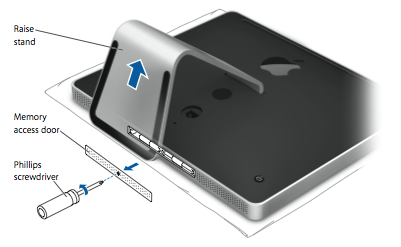
- Remove the access door and set it aside.
- Untuck the tab in the memory compartment. If you're replacing a memory module, untuck the tab and pull it to eject any installed memory module:
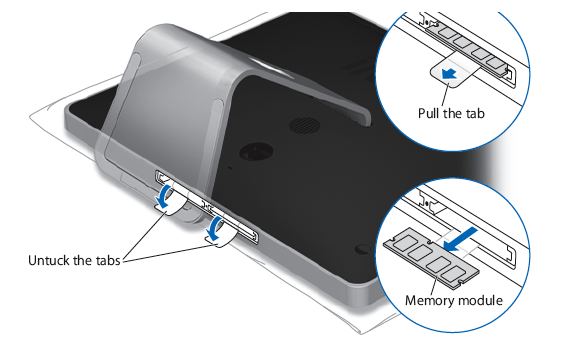
- Insert your new or replacement RAM SO-DIMM into the empty slot, noting the orientation of the keyway of the SO-DIMM as shown above.
- After you've inserted it, press the DIMM up into the slot. There should be a slight click when the memory has been seated correctly.
- Tuck the tabs above the memory DIMMs and reinstall the memory access door:
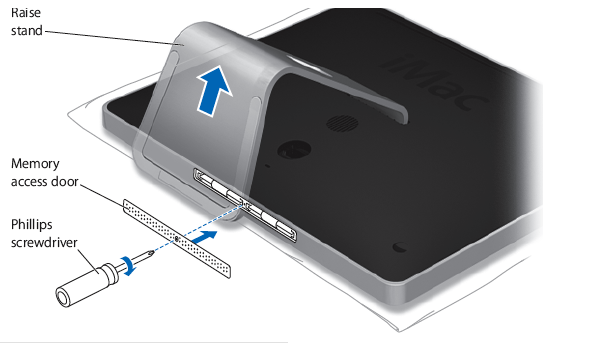
- Place the computer in its upright position. Reconnect the power cable and all other cables to the computer, then start up the computer.

For these 20-inch and 17-inch models
Get memory specifications for the following iMac models, then find out how to install memory in them:
- iMac (20-inch, Late 2006)
- iMac (17-inch, Late 2006 CD)
- iMac (17-inch, Late 2006)
- iMac (17-inch, Mid 2006)
- iMac (20-inch, Early 2006)
- iMac (17-inch, Early 2006)
Memory specifications
| Number of memory slots | 2 | ||
| Base memory | 1 GB | Two 512 MB DIMMs; one in each of the memory slots | iMac (Late 2006) |
| 512 MB | One DDR2 SDRAM installed in the top slot | iMac (17-inch Late 2006 CD) | |
| 512 MB | Two 256 MB DIMMs; one in each of the memory slots | iMac (Mid 2006) | |
| 512 MB | One DDR2 SDRAM installed in the top slot | iMac (Early 2006) | |
| Maximum memory | 4 GB | 2 GB SO-DIMM in each of the two slots* | iMac (Late 2006) |
| 2 GB | 1 GB SO-DIMM in each of the two slots | iMac (17-inch Late 2006 CD) iMac (Early 2006) |
|
| Memory card specifications | Compatible: - Small outline dual inline memory module (DDR SO-DIMM) format - PC2-5300 - Non-parity - 200-pin - 667 MHz - DDR3 SDRAM |
Not compatible: - Registers or buffers - PLLs - ECC - Parity - EDO RAM |
|
For the best performance, fill both memory slots, installing an equal memory module in each slot.
*iMac (Late 2006) uses a maximum of 3 GB of RAM.
Installing memory in the bottom slot
The internal components of your iMac can get warm. If you've been using your iMac, wait 10 minutes after shutting it down to allow the internal components to cool.
After you've shut down your iMac and given it some time to cool down, follow these steps:
- Disconnect the power cable and all other cables from your computer.
- Place a soft, clean towel or cloth on a desk or other flat surface to prevent the display from getting scratched.
- Hold the sides of the computer and slowly place the computer face down on the towel or cloth.
- Using a Phillips screwdriver, remove the RAM access door on the bottom of the iMac and set it aside:
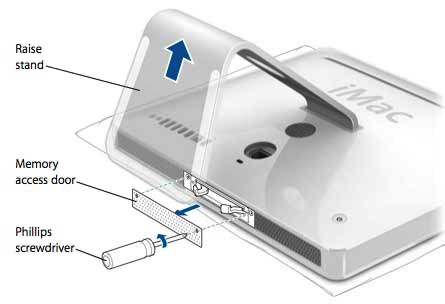
- Move the DIMM ejector clips to their fully open position:
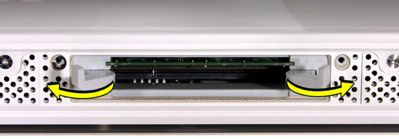
- Insert your RAM SO-DIMM into the bottom slot, keeping in mind the orientation of the keyed SO-DIMM:
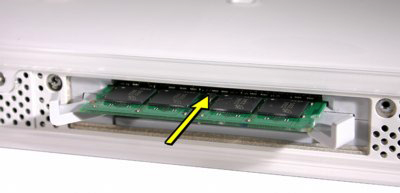
- After you've inserted it, press the DIMM up into the slot with your thumbs. Don't use the DIMM ejector clips to push in the DIMM, as this can damage the SDRAM DIMM. There should be a slight click when the memory has been seated correctly.
- Close the ejector clips:
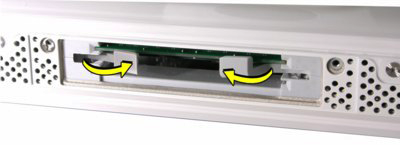
- Reinstall the memory access door:

- Place the computer in its upright position. Reconnect the power cable and all other cables to the computer, then start up the computer.
Replacing memory in the top slot
After you've shut down your iMac and given it some time to cool down, follow these steps:
- Disconnect the power cable and all other cables from your computer.
- Place a soft, clean towel or cloth on a desk or other flat surface to prevent the display from getting scratched.
- Hold the sides of the computer and slowly place the computer face down on the towel or cloth.
- Using a Phillips screwdriver, remove the RAM access door on the bottom of the iMac and set it aside:

- Pull the two levers on each side of the memory compartment to eject the memory module that's already installed:

- Remove the memory module from your iMac as shown below:
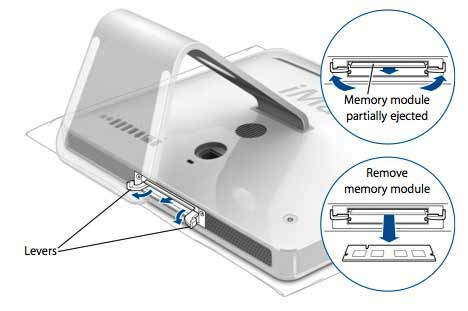
- Insert your RAM SO-DIMM into the top slot, noting the orientation of the keyed SO-DIMM:

- After you've inserted it, press the DIMM up into the slot with your thumbs. Don't use the DIMM ejector clips to push in the DIMM, as this can damage the SDRAM DIMM. There should be a slight click when the memory has been seated correctly.
- Close the ejector clips:

- Reinstall the memory access door:
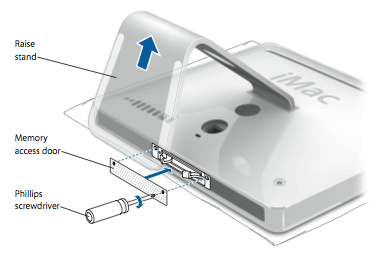
- Place the computer in its upright position. Reconnect the power cable and all other cables to the computer, then start up the computer.

Confirm that your iMac recognises its new memory
After you've installed memory, you should confirm that your iMac recognises the new RAM by choosing Apple () menu > About This Mac.
The window that appears lists the total memory, including the amount of memory that originally came with the computer plus the newly added memory. If all the memory in the iMac has been replaced, it lists the new total of all installed RAM.
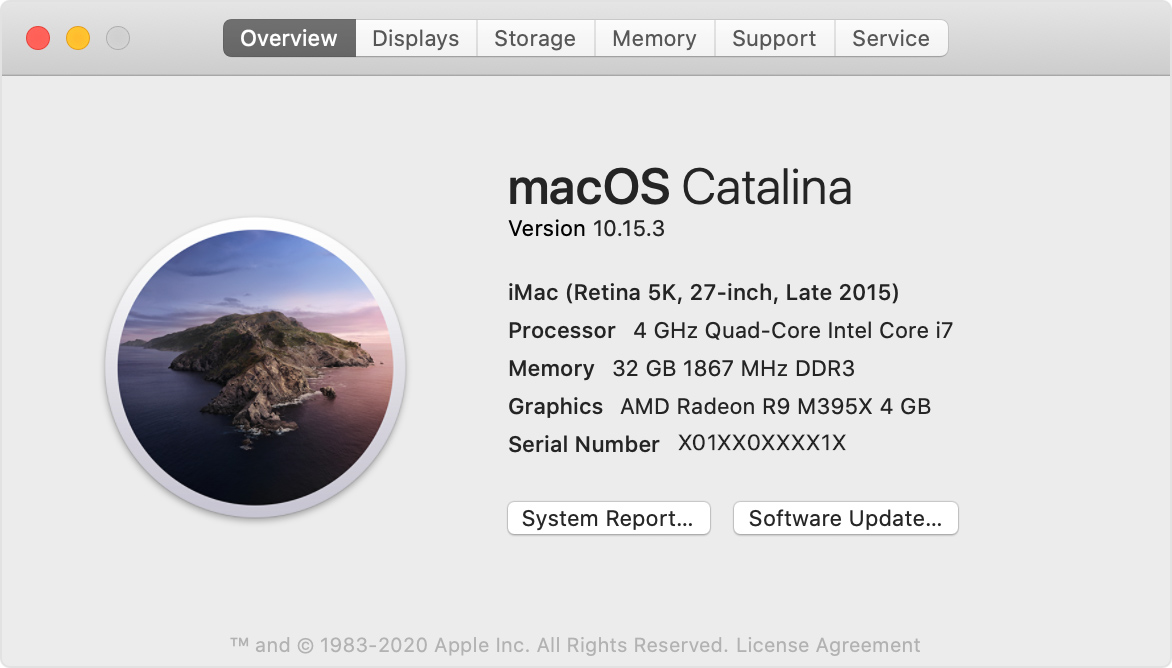
For detailed information about the memory installed in your iMac, click System Report. Then choose Memory under the Hardware section in the left-hand side of System Information.
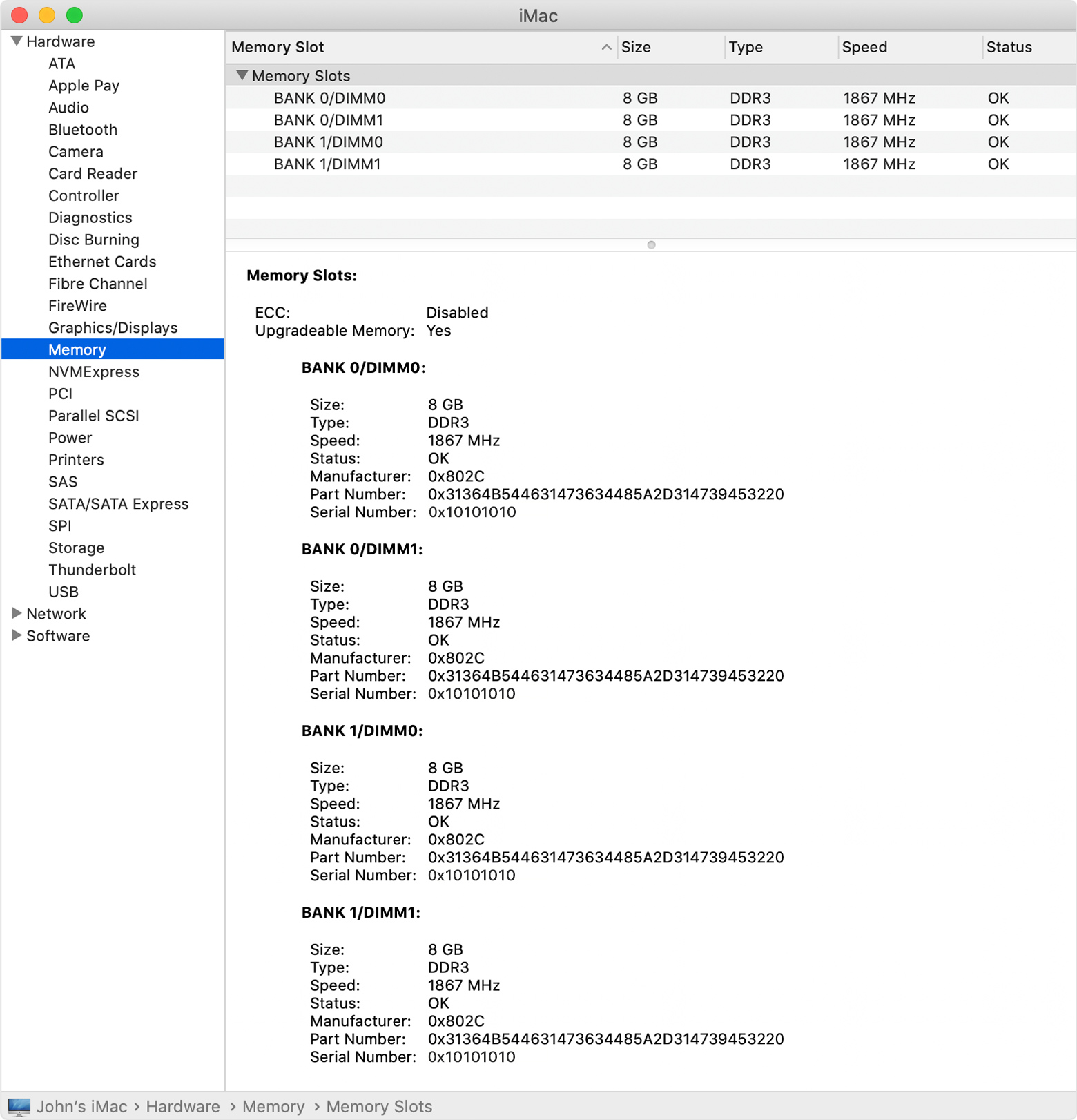
If your iMac doesn’t start up after you've installed additional memory
If your iMac doesn’t start up or turn on after you've installed additional memory, check each of the following, then try to start your iMac again.
- Verify the memory you're trying to add is compatible with your iMac.
- Visually inspect each DIMM to ensure they have been installed correctly and are fully seated. If one DIMM is sitting higher or is not parallel with the other DIMMs, remove and inspect the DIMMs before reinstalling them. Each DIMM is keyed and can only be inserted in one direction.
- Confirm that the memory cage levers are locked into place.
- Make sure you allow the memory initialisation process to finish during startup. Newer iMac models perform a memory initialisation procedure during startup after you've upgraded memory, reset NVRAM or rearranged DIMMs. This process can take 30 seconds or longer, and the display of your iMac will remain dark until the process has finished.
- Disconnect all attached peripherals other than the keyboard, mouse or trackpad. If the iMac starts working correctly, reattach each peripheral, one at a time, to determine which one is preventing the iMac from operating correctly.
- If the issue persists, remove the upgraded DIMMs and reinstall the original DIMMs. If the iMac works correctly with the original DIMMs, contact the memory vendor or place of purchase for assistance.
If your iMac makes a tone after you've installed memory
iMac models introduced before 2017 may make a warning sound when you start up after installing or replacing memory:
- One tone, repeating every five seconds, signals that no RAM is installed.
- Three successive tones, then a five-second pause (repeating) signals that RAM doesn't pass a data integrity check.
If you hear these tones, confirm that the memory you've installed is compatible with your iMac and that it's been installed correctly by reseating the memory. If your iMac continues to make the tone, contact Apple Support.

1. Memory is integrated into the Apple M-series chip package in iMac (24-inch, 2023) and iMac (24-inch, M1, 2021) and can’t be upgraded. You can configure the memory in your iMac after you've purchased it.
2. Memory in iMac (21.5-inch, Late 2015), and iMac (Retina 4K, 21.5-inch, Late 2015) is not upgradeable.
3. Memory is not removable by users on iMac (21.5-inch, Late 2012), iMac (21.5-inch, Late 2013), iMac (21.5-inch, Mid 2014), iMac (21.5-inch, 2017), iMac (Retina 4K, 21.5-inch, 2017) and iMac (Retina 4K, 21.5-inch, 2019). If the memory in one of these computers needs a service to repair it, contact an Apple Retail Store or Apple Authorised Service Provider. If you’d like to upgrade the memory in one of these models, an Apple Authorised Service Provider can help. Before you schedule an appointment, confirm that the specific Apple Authorised Service Provider offers memory upgrade services.